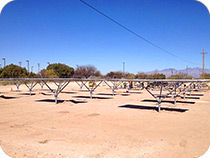The Challenge
In utility-scale ground-mounted arrays, the site is typically large, uniform, and free from obstructions. The installation process must be extremely efficient, so any products installed must be compatible with a fast work flow.
Benefits of the RTS
Installed Cost Similar to Single-Axis
The QBotix utility scale solar tracking system can increase the IRR of any project by increasing yield while minimizing cost, thereby enabling both superior returns and lower Power Purchase Agreement (PPA) bid rates.
Maximum IRR
The Robotic Tracking System provides a highly differentiated way to increase the yield and profitability of a ground-mounted array. The proprietary optimized tracking can provide up to 15% more energy than single-axis tracking, and up to 40% more energy than fixed-tilt arrays.
High Ground Coverage Ratio
The RTS can also support high Ground Coverage Ratios (GCR’s) of 0.40 or more, which is twice that of traditional dual-axis tracker GCR’s. For space-constrained systems, no other technology can offer as high of a total NPV as the Robotic Tracking System.
Fast Installation, Easy Site Management
RTS arrays can be installed 20% faster than comparable single-axis trackers and significantly faster than dual-axis trackers. In addition to lowering direct labor costs, the RTS installation speed helps EPC’s increase annual installed capacity and revenue. The RTS creates site design flexibility that minimizes or eliminates land grading and heavy machinery.
Risk Mitigation
The RTS offers a rugged design and maximum system availability. The athermalized design can stand up to large temperature swings with a maximum temperature of 131°F (55°C), and the NEMA 4X equipment can survive the harshest storm or dust load. The RTS also provides continuous information on the status of the array to enable automated and remote troubleshooting, reduce diagnostic time in the filed, and streamline O&M visits.
Conclusion
The Robotic Tracking System represents a rugged and reliable approach to delivering maximum energy production and compelling economics in systems at the largest scale.
